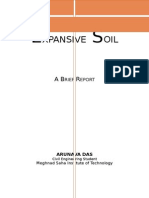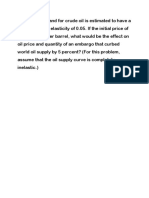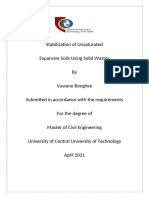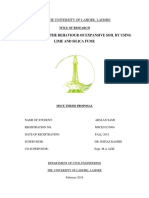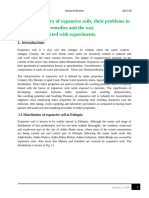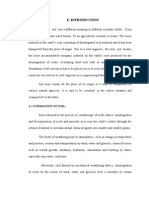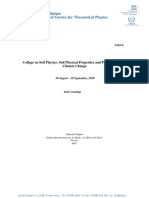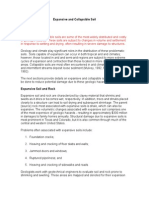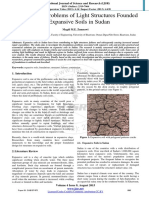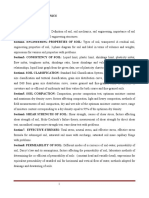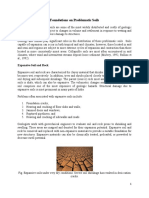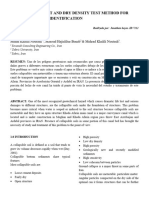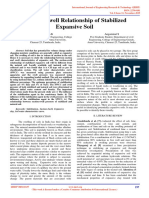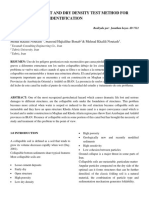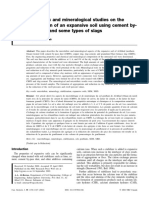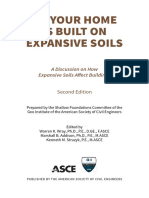Expansive Soil: Causes and Treatments: I-Manager's Journal On Civil Engineering January 2016
Expansive Soil: Causes and Treatments: I-Manager's Journal On Civil Engineering January 2016
Uploaded by
pooCopyright:
Available Formats
Expansive Soil: Causes and Treatments: I-Manager's Journal On Civil Engineering January 2016
Expansive Soil: Causes and Treatments: I-Manager's Journal On Civil Engineering January 2016
Uploaded by
pooOriginal Title
Copyright
Available Formats
Share this document
Did you find this document useful?
Is this content inappropriate?
Copyright:
Available Formats
Expansive Soil: Causes and Treatments: I-Manager's Journal On Civil Engineering January 2016
Expansive Soil: Causes and Treatments: I-Manager's Journal On Civil Engineering January 2016
Uploaded by
pooCopyright:
Available Formats
See discussions, stats, and author profiles for this publication at: https://www.researchgate.
net/publication/322912709
EXPANSIVE SOIL: CAUSES AND TREATMENTS
Article in i-manager’s Journal on Civil Engineering · January 2016
DOI: 10.26634/jce.6.3.8083
CITATIONS READS
7 9,218
2 authors, including:
Faezehossadat Khademi
Illinois Institute of Technology
27 PUBLICATIONS 340 CITATIONS
SEE PROFILE
Some of the authors of this publication are also working on these related projects:
concrete technology View project
measuring compressive strength pf puzzolan concrete by Ultrasonic pulse velocity View project
All content following this page was uploaded by Faezehossadat Khademi on 13 July 2018.
The user has requested enhancement of the downloaded file.
RESEARCH PAPERS
EXPANSIVE SOIL: CAUSES AND TREATMENTS
By
FAEZEHOSSADAT KHADEMI * JEFF BUDIMAN **
* Ph.D Scholar, Department of Civil, Architectural, and Environmental Engineering, Illinois Institute of Technology, Chicago, USA.
** Associate Professor, Department of Civil, Architectural, and Environmental Engineering, Illinois Institute of Technology, Chicago, USA.
ABSTRACT
The expansive soil problems lead to structural and geotechnical engineering challenges all over the world. Expansive
soils are the type of soils which their volume changes considerably depend on their water content. It is worth mentioning
that, the expansive soil problems can occur in both humid environments and arid/semi-arid soils.
Buildings, roads, pipelines, and other structural members have always been subjected to damages resulted from
expansive soils which this damage is even more than twice the damage resulted from floods, hurricanes, earthquakes,
and tornadoes. Understanding the behaviour and characteristics of these types of soils can help scientists control the
imposed damages to the structure. This paper is a comprehensive study on expansive soils, its nature, shrinkage-swell
behaviour, as well as expansive soil causes and treatments.
Keywords: Expansive Soil, Swelling, Shrinkage, Causes of Expansive Soil, Treatments of Expansive Soil.
INTRODUCTION soil, the higher the soil swells and the more water the soil
Expansive or swelling soil is a highly plastic soil that normally can absorb. In addition, the more water they absorb, the
contains montmorillonite and other active clay minerals. more their volume increases. In other words, when the
Expansive soil is a commonly identified problem which has water is attracted by these type of soils, they would get
made scientists concern about the design, protection, and increased in volume and hence they would swell. In
operating of highway and structural systems. Expansive contrast, the shrinkage happens when the soil gets dry.
soils can be found in arid/semi-arid areas, where even Researchers have reported the safe expansion
moderate expansive soils can cause major damages to percentage equal or smaller than 10% for most of the
the structure or in humid environments where just expansive expansive clays (Jones & Jefferson, 2012).
soils with high plasticity index (Ip) can lead the structure to In order to determine the soil shrinkage and swelling
be damaged. The behaviors of an expansive soil can be amount, the water content in the near-surface zone can
affected by many factors, among which the principal ones be measured. Normally, most of the significant action
are the availability of moisture, and the amount and type of happens in the depth not more than 3 meters, although if
the clay-size particles in the soil. It is worth mentioning that the tree roots exist in the area, this amount can be
when the water changes in expansive soil, the volume extended. The characteristics of fine-grained clay-rich soils
would be changed as well. These volume changes can leads them to be capable enough to absorb large
lead to either swelling or shrinkage and that is why amount of water which makes them to be heavy and sticky.
expansive soils are also known as swell/shrink soils (Ardani, On the other hand, these types of soils can become very
1992; Day, 2000; Jones & Jefferson, 2012; Zemenu et al., hard when they dry, which leads them to shrink and have
2009; Ito and Azam, 2010; Liu et al., 2015). Although cracks on their body. This procedure is known as "shrinkage-
expansion can be the result of the chemically induced swell" behavior (Jones & Jefferson, 2012).
changes, most of the times soils which have swelling and Swelling and shrinkage are not wholly reversible procedure
shrinkage behavior contain expansive clay minerals. It can (Holtz & Kovacs, 1981). Shrinkage results in cracks on the
be resulted in the fact that, the more the clay exists in the body of the soil which cannot close-up completely by re-
i-manager’s Journal on Civil Engineering, Vol. 6 l
No. 3 l
June - August 2016 1
RESEARCH PAPERS
wetting the soil. Therefore, it makes the soil to bulk-out
somehow. In addition, it can help the water to penetrate
into the soil more easily during the swelling process. It is
worth mentioning that when substances like sediment
enters the existing cracks in the soil, the soil is unable to get
rid of them and go back to its previous situation, hence it will
result in the increase in the swelling pressure. Sometimes,
the shrinkage cracks may be filled with sediment which
leads to the incompatibility of the soil.
One of the primary problems with the expansive soil is that
deformations are considerably greater than the predicted
ones which is obtained from the classical elastic and
plastic theory (Jones & Jefferson, 2012).
The two major factors in treating expansive soils are: (1)
Identifying, and (2) estimating the anticipated potential
volume change of the subgrade soils (Ardani, 1992).
In this paper, firstly the expansive soil is identified
comprehensively. Second, the causes and required Figure 1. Listings of the Methods Used in Each Categorization for
Identification of the Expansive Soil
treatments for expansive soil is discussed.
the soil.
1. Identification of Expansive Soils
2. Mechanics of Expansive Soils
The success, safety, and economy of the structure is
strongly dependent on the situation of the rock and soil at Expansive soils are the ones which generally exhibit a large
the place as well as the interaction of the ground materials amount of volume changes due to environmental
during and after the construction. Large amount of ground changes and water absorption of the soil. These types of
deformations is one of the most significant problems in soils contain clay particles of one or more minerals, which
expansive soils which is the result of swelling and shrinkage are eager to absorb a large amount of water. When the
of the soil. The excessive movements can lead to both water is absorbed, these particles grow and hence, the
damage and negative impact on the structural materials containing the clays would have expansion
performance in terms of cost and time (Reddy et al. 2009). (Ardani, 1992).
Therefore, identifying the expansive soils can help The soil mineralogy can be explained as the chemical
researchers reduce the imposed damages resulted from organization of molecules into sheets that results in having
the expansive soil to the structure. the clay smaller than 0.002 millimetre, which have the
Identification of the expansive soil can be expressed in the ability to swell and shrink easily. The clay particles should be
two following categorizations; (1) Those used for made up of many layers, either 1:1 or 2:1. If they are made
mineralogical identification, and (2) those used for direct up of 1:1 clay layers, they would be slightly expansive. On
physical properties (Ardani, 1992). Figure 1 lists the methods the other hand, if they are made up of 2:1 clay layers, they
used in each group. would be expansive soils. It is important to mention that the
non-expansive clay minerals does not exist. Clay minerals
It is worth mentioning that mineral identification methods
can be defined as hydrous aluminium phyllosilicates
are not only too time-consuming, but also requiring special
minerals that are fine grained with sheet like structures and
expertise and equipment. Therefore, most experts prefer
very high surface areas. The clay minerals are the
simple identification tests based on physical properties of
combination of silcon-oxygen tetrahedral, aluminium or
2 i-manager’s Journal on Civil Engineering, Vol. 6 l
No. 3 l
June - August 2016
RESEARCH PAPERS
magnesium, and the brucite or gibbsite sheet in the
octahedral layer (Lucian, 2008). Figure 2 shows the Basic
layer structure of a natural clay mineral (Daulton, 2005).
Investigation have shown that MONTMORILLONITE minerals
have the greatest volume change in comparison to all the
other clay minerals. This fact can be expressed as the
penetration of the water into the interlayer molecular
spaces in MONTMORILLONITE minerals. It is worth
mentioning that if the sodium exists in these minerals, it can
result in the swelling of the clay multiple times its real
volume. The effect of MONTMORILLONITE minerals on
expansive soils can be presented by the vertical in situ
suction profile (Ardani, 1992).
The basic parameters which affect the potential
expansiveness of the given soil are: (1) The type and
swelling potential of the clay mineral, (2) the moisture
Figure 3. Commonly used Criteria for Determining Swell Potential
content of the soil, and (3) the density of the soil (Ardani,
from Across the World (Jones & Jefferson, 2012)
1992).
4. Seasonal Variations in Water Content
3. Characterization
The seasonal volumetric change of desiccated soil is
In order to classify the shrinkage and swelling, the scientists
complex which enhances with severity of the existing
have done many researches to obtain a universally
shrinkage (Jones & Jefferson, 2012). The vertical in situ
applicable system. Some have even tried to create a
suction profile, water content profile and the degree of
unified swelling potential index using commonly used
saturation reflect this fact as it is demonstrated in Figure 4.
indices (Kariuki and Van Dur Meer, 2004; Yilmaz, 2006) or
Here pF is the base 10 logarithm of the water potential in
from specific surface areas (Yukselen-Aksoy and Kaya,
cm.
2010), but these are as yet to be adopted. Figure 3 shows
the examples of different schemes which are generally
used all over the world.
Scientists believe that there is still the lack of standard
definitions of the swell potential due to the fact that both
testing factors and sample conditions vary extensively
(Jones & Jefferson, 2012).
Figure 2. Clay Mineral Layers (Daulton, 2005) Figure 4. Examples of Total Suction Profile (Fityus et al., 2004)
i-manager’s Journal on Civil Engineering, Vol. 6 l
No. 3 l
June - August 2016 3
RESEARCH PAPERS
The relative values of suction are dependent on the ·Active Zone
composition of the soil, specially its particle size and clay The zone of soil that contributes to soil expansion at any
mineral content. The soil hydraulic conductivity may particular time.
fluctuate both seasonally and over longer timescales. It is
·Zone of Seasonal Moisture Fluctuation
worth mentioning that fabric changes, tension cracking,
The zone in which water content change due to climate
and shallow shear failure during the swelling and shrinkage
changes at the ground surface.
process which may affect the subsequent moisture
movements can lead to the secondary permeabilities ·Depth of Wetting
(Jones & Jefferson, 2012). Expansive soil problems usually The depth to which water contents have enhanced
happen because of the changes in the water content in because of the introduction of water from external sources.
the upper few meters, with deep seated heave being rare. ·Depth of Potential Heave
The climate and environmental parameters considerably
This is the maximum depth of the active zone. The depth at
affect the water content in these upper layers. The water
which the overburden vertical stress equals or is greater the
content is generally termed the zone of seasonal
swelling pressure of the soil.
fluctuations or active zones as shown in Figure 5 (Jones &
5. Why Expansive Soils Cause Damage?
Jefferson, 2012).
There are many towns, transport routes and buildings which
In the active zone, negative pore water pressures exist,
are located on clay-rich soil and rocks. The clay within these
however, if the surface absorbs extra water or if
materials is so sensitive to shrinkage and swelling which is
evapotranspiration is eliminated then water content will
due to changes in the water content. This can lead to a
enhance and heave will happen. In addition, temperature
significant hazard to engineering construction. Change in
can influence the migration of water through the zone as it
water content may be due to seasonal effects which are
is shown in Figure 5. Therefore, when the site investigation is
based on rainfall and evapotranspiration of vegetation, or it
performed, it is significant to verify the depth of the active
might be due site changes such as leakage from water
zone. The depth of this zone will increase if the drying is
supplier or drains, changes to drainage of the surface and
greater than rehydration.
landscaping including paving, or following the planting,
"Active Zone" have been explained with different meanings
removal or severe pruning of trees or hedges, as man is
which are explained as the followings (Jones & Jefferson
unable to supply water to desiccated soil as efficiently as a
2012):
tree originally extracted it through its root system (Jones &
Jefferson, 2012).
The permanent water deficit may grow during a long dry
period which leads to the soil higher dry depth than normal
and hence, long-term subsidence of the ground. This fact
can explain why expansive problems are usually found in
arid areas. As this water deficit dissipates, it is possible that
long-term heave may occur (Jones & Jefferson, 2012).
Pressure resulted from swelling can cause heaving or lifting,
while shrinkage can cause differential settlement. In
general, when the soil volume changes are unevenly
distributed beneath the foundation, failure occurs. For
instance, if the water content changes in the soil around the
Figure 5. Water Content Profiles in the Active Zone
(Jones & Jefferson, 2012)
perimeter of the building, it can lead to the swelling
pressure beneath it, although the water content of the soil
4 i-manager’s Journal on Civil Engineering, Vol. 6 l
No. 3 l
June - August 2016
RESEARCH PAPERS
beneath the center of the building stays the same. This
results in failure known as end lift. On the other hand, the
opposite situation of the end lift is known as center lift, which
swelling happens beneath the center of the structure or
which shrinkage occurs under the edges (Jones, 2011).
Both of the cases are shown in Figure 6.
In addition, an example for results in failure known as end lift
is shown in Figure 7.
Normally, damage foundation due to expansive soil results
from tree growth which happens in two general ways,
·Physical disturbance of the ground, and
·Shrinkage of the ground by removal of water.
Physical disturbance of the ground caused by root growth is
most of the times seen as damage to pavements and
Figure 8. Example of Differential Settlement due to Influence of
Broken walls. Figure 8 shows an example of vegetation
Trees (Jones & Jefferson, 2012)
induced shrinkage causing differential settlement of
significant activities of the ground. These movements are in
building foundation. Vegetation induced changes to water
both vertical and horizontal direction which generate
profiles can also have an important effect on other
significantly tensile stresses when in the neighbourhood of
underground feature, including utilities. Clayton et al.
trees. Such trees induced movement has the ability to be
(2010) reported monitoring data for a two-year duration of
an important contributor to failure of old pipes placed in
a pipe in London Clay, which led to understanding the
clay soils near deciduous trees (Clayton et al., 2010).
Another case is shown in Figure 9 which the damage is
caused by upward soil expansion.
In addition, Figure 10 is showing an example of expansive
soil problems on the structure of the building.
Figure 11 shows another example of the damage caused
by expansive soil.
Figure 6. Foundation Movements Which Cause Building Distress
Figure 9. Damage to Residential Building Caused by Highly Plastic
Clays Shrinking and Swelling with Moisture Changes in the
Figure 7. Structural Damage to House Caused by 'End Lift' Foundation (Mokhtari & Dehghani, 2012)
(Mokhtari & Dehghani, 2012)
i-manager’s Journal on Civil Engineering, Vol. 6 l
No. 3 l
June - August 2016 5
RESEARCH PAPERS
Figure 12. A Uniformly Loaded Rectangular Slab which Tend to
Lift Up in the Corners Due to Less Confinement (Rogers et al. 1993)
Figure 10. Major Cracks in Exterior Walls at Doors and Windows
(Mokhtari & Dehghani, 2012)
a lot of parameters which include climate, financial, legal,
and technical issues. It is worth mentioning that swell/shrink
behaviour usually does not manifest itself for a long time
and so design alternatives must take account of this.
Regularly higher initial costs are offset many times over by a
reduction in post construction maintenance costs when
dealing with expansive soils (Jones & Jefferson, 2012).
Foundation alternatives when encountering the potentially
expansive soils follow three choices of:
·Using the structural alternatives, e.g. stiffened raft,
·Using the ground improvement techniques, and
·Combination of 1 and 2 (Jones & Jefferson, 2012).
Figure 11. Residual Driveway Damaged by Expansive Soil Two factors are important to be paid attention while
(Mokhtari & Dehghani, 2012)
dealing with expansive soil:
5.1 Foundation Options in Expansive Soils
·Isolate structure from soil movement, and
The most common way which foundations can be
·Design a foundation stiff enough to resist movements
damaged by is uplift which is caused by expansive soils.
(Jones & Jefferson, 2012).
Swelling soils lift up and crack lightly-loaded, continuous
strip footings, and frequently cause distress in floor slabs. Scientists have reported major types of foundations used in
The resultant uplift varies in different areas under the expansive soils from around the world are pier and beam or
building due to the various building loads on different pile and beam systems, reinforced raft sand modified
portions of a structure’s foundation. According to Figure 12, continuous perimeter spread footings as are summarized
the outer corners of a uniformly-loaded rectangular slab in Figure 13 (Jones & Jefferson, 2012).
foundation will only exert about one-fourth of the usual In addition, a brief description of each is given below.
pressure on a swelling soil located at the central portion of 5.1.1 Pier and Beam/ Pile and Beam Foundations
the slab. Accordingly, the corners tend to be lifted up In this case, for the purpose of supporting the structural
relative to the central portion. Moisture differentials within loads and transferring the loads to the piers and piles, the
soils located at the edges of the slab intensify this incident. foundation should consist of a ground beam. In order to
Such foundation differential movements can result in the isolate the structure and prevent uplift from swelling
distress to the framing of the structure (Rogers et al., 1993). between the pier/pile and ground beam, a void is supplied.
Foundation types and design methods can be affected by Floors are then constructed as floating slabs. The piers/piles
6 i-manager’s Journal on Civil Engineering, Vol. 6 l
No. 3 l
June - August 2016
RESEARCH PAPERS
Figure 14. Illustration of a Pier and Beam Foundations
(Jones & Jefferson, 2012)
and removed after the beam is cast to prevent a means to
transmit swell pressures. It is important to mention that all the
approaches are strong enough to prevent possible
pathways to let water to enter to deeper layers as this will
cause deep seated swelling (Jones & Jefferson, 2012).
5.1.2. Stiffened Rafts
Figure 13. Foundation Types Used in Expansive Soils Usually stiffened slabs are reinforced concrete, although in
(Jones & Jefferson, 2012)
countries like the United States post tensioned systems are
can be explained as reinforced concrete shafts with or used. Design procedures are explained as determining
without belled bottoms, steel piles driven or pushed, or bending moments, shear and deflections associated with
helical pile which is used to transfer loads to stable strata. structural and swell pressure loads. Figure 15 shows the
Under-reamed bottoms and helical piers/piles can general layout used commonly in the United States (Jones
perform successfully in soils with a high swell potential & Jefferson 2012).
overcoming the impractical length. Otherwise straight For designing the Stiffened Rafts, the slab should be
shaft piers/piles would be required in this situation. In considered as a beam resting on an elastic medium or
addition, under-reamed bottoms and helical piers/piles loaded plate. This design is modelled on soil-structure
can be used in the regions where the loss of skin friction due
to increasing groundwater levels is possible. Figure 14
illustrates a typical pier and beam foundation from US
practice (Jones & Jefferson, 2012).
It is worth mentioning that there should be enough
anchorage below the active zone. Pier/pile diameters are
kept small, which is typically 300 to 450 mm diameters. Any
smaller size will result in poor concrete placement and
related defects, e.g. void spaces. Other problems that can
occur include 'mushrooming' next to the top of the
pier/pile, which if occurs presents additional vicinity for uplift
forces to act. Cylindrical cardboard forms are a solution to Figure 15. Typical Detail of a Stiffened Raft (Jones &
avoid this in many countries. They are usually employed Jefferson, 2012)
i-manager’s Journal on Civil Engineering, Vol. 6 l
No. 3 l
June - August 2016 7
RESEARCH PAPERS
interaction at the base of the slab. There are two strict 5.1.3 Modified Continuous Perimeter Footing
modes of movement: Whenever expansive soils exists in a region, shallow footing
·Where a ground profile develops assuming a should be prevented. However, if they are used in an area,
weightless slab, and in order to reduce the effect of swelling/shrinkage; some
·Where a slab of infinite stiffness is placed on the Delling modifications would be required which are:
soil. ·Narrowing footing width,
The actual movement of the slab exhibits some flexibility ·Providing void spaces within support beam/wall to
and hence, is something between these two movements. concentrate loads at isolated points, and
All the three modes of movements are illustrated in Figure ·Increasing perimeter reinforcement taking this into the
16 (Jones & Jefferson, 2012). floor slab stiffening foundations (Jones & Jefferson,
The required geotechnical information include size, shape, 2012).
and properties of the distorted soils surface that developed Whenever the narrow spread footing is used in expansive
beneath the slab. This is dependent on many parameters soils, the use of it should be limited to soils exhibiting 1%
such as soil stiffness, heave, initial water content, climate, swell potential and very low swell pressures (Jones &
water distributions, time post construction, loading and slab Jefferson, 2012).
rigidity. Usually, center of the slab is subjected to severe long
5.2 Pavement and Expansive Soils
term distortion. In this method, the slab through its
Pavements are vulnerable to expansive soil damage
elimination of evapotranspiration promote the largest
because of their relative lightweight nature extended over
increase in water content near to the center of the slab and
a relatively large area. Damage to pavements on
hence, it can solve the distortion problem of the center of
expansive soil comes in four major forms:
the slab. On the other hand, it is found that the maximum
differential heave varies between 33 to 100 % of total ·Severe unevenness along significant lengths- cracks
maximum heave. When the exterior of a structure may or may not be visible (particularly important for
experiences water content growth before the interior areas airport runways),
heave can occur on occasion edges (Jones & Jefferson, ·Longitudinal cracking,
2012). ·Lateral cracking developed from significant localized
deformations, and
·Localized pavement failure associated with
disintegration of the surface (Jones & Jefferson, 2012).
(a)
Pavement designs are considered based on either flexible
or rigid pavement systems (Nelson & Miller, 1992). However,
whenever we want to assume the effect of the expansive
soil, a number of issues should be considered:
(b) ·Choose an alternative route and avoid path on
expansive soil,
·Remove and replace expansive soil with a non-
expansive alternative,
·Design for a low strength and allow regular
(c) maintenance,
Figure 16. Profiles After Construction for Various Stiffness of Raft
·Physically modify expansive soils through disturbance
(a) Profile with No Load Applied, (b) Profile with Infinitely Stiff Slab,
(c) Profile with Flexible Slab (Jones & Jefferson, 2012) and re-compaction,
8 i-manager’s Journal on Civil Engineering, Vol. 6 l
No. 3 l
June - August 2016
RESEARCH PAPERS
·Stabilization through chemical additives, such a lime loads should be applied to the specimen. The results of
treatment, and odometer swell test illustrates the deformation of the soil
·Control water content changes although very difficult with respect to its change in effective stress.
over the life of a pavement (Jones & Jefferson, 2012). Although this test is used broadly for measuring the swelling
6. Potential Volume Change Prediction clays, the procedures which are utilized for this test are quite
diverse. Fredlund (1969) has mentioned two types of
In order to select the most suitable treatment method, it is
swelling test as the most popular ones;
essential to predict the potential volume change of
expansive soil accurately. It is worth mentioning that there is ·Free Swell test (FS), and
no definite dividing line between the methods of predicting ·The Constant Volume test (CV) (Fredlund, 1969).
the volume change and some identification methods. To In the free swell test, the soil volume is permitted to be
overall, three different techniques are used to predict the changed until equilibrium is achieved. The specimen
soil volume change which are: should be both loaded and unloaded in conventional
·Soil suction test, manner. In order to reduce the volume of the specimen to
·Odometer swell test (consolidometer testing), and its original volume, the specific pressure is required which is
called the swelling pressure of the soil. In the constant
·Potential Vertical Rise (PVR) (Ardani, 1992).
volume test, the total stress on the soil specimen is
Once an expansive soil has been known and distinguished
increased after submerging in order to prevent it from
using the stated methods, the volume change can be
volume changing. In this method, the pressure at which
anticipated. These methods are explained by detail in the
there is neither a tendency for enhancing or reducing the
following:
volume is termed the soil swelling pressure (Fredlund, 1969).
6.1. Soil Suction Test
6.3 Potential Vertical Rise (PVR)
As the volume change is considerably dependent on the
The Potential Vertical Rise method design procedure was
water content of the soil, soil suction test can be used to
initially created by Chester McDowell in 1956. In this
estimate this change. In order to apply the theories of the
method, the anticipated vertical rise is related to both the
engineering behaviour of unsaturated soils, it is mandatory
plasticity index of the soil and the field loading. It can be
to measure the soil suction. The mechanism of the soil
also identified as the soil potential to swell at a specific
suction measurement can be explained as evaluating the
loading condition, moisture, and density. Comparison of
moisture condition of the unsaturated soils. The filter paper
potential vertical rise with field results illustrates that in most
method is both inexpensive and simple laboratory test
of the cases, the PVR method over predicts the vertical rise
method which can measure both total and matric suction.
that would happen (Zornberg et al. 2009).
If the soil suction test is performed accurate, the initial and
7. Methods for Treatment of Expansive Soil
final soil suction profiles can be obtained from samples
taken at convenient depth intervals. The change in suction The following methods have been presented for the
with seasonal moisture movement is a significant treatment of expansive soil (Ardani, 1992):
information for many scientists to predict the potential ·Sub-excavation and removal of expansive soil and
volume change of the soil (Bulut et al., 2001). replacement with non-expansive soil.
6.2. Odometer Swell Test (Consolidometer Testing) ·Application of heavy applied load to balance the
The one-dimensional consolidometer has been used swelling pressure.
widely for testing the swelling tests. This test is one of the ·Preventing access of water to the soil by encapsulation.
most popular tests in geotechnical engineering for ·Stabilization by means of chemical admixtures.
measuring the consolidation properties of the soil. In order
·Mechanical stabilization.
to evaluate the deformation response in this test, different
i-manager’s Journal on Civil Engineering, Vol. 6 l
No. 3 l
June - August 2016 9
RESEARCH PAPERS
·Pre-wetting the soil. Grand Junction, a full size, non-experimental project was
·Avoiding the expansive soil. constructed in northwestern Colorado during the summer
and fall of 1967 (Brakey, 1968).
7.1 Sub-excavation and Removal of Expansive Soil and
Replacement with Non-Expansive Soil The catalytically blown asphalt membrane has been used
in a project located just west of the village of Elk Springs on
Sub-excavation and replacement is the result of removing
US 40 and it was placed on all the bases of the expansive
and replacing the expansive subgrade soils. The replaced
soil cuts. In order to cover two miles of 2-lane roadway, four
material should not make problems with respect to the in
hundred and forty five tons of catalytically blown asphalt
situ material. For instance, granular soils should never be
membrane were used in this project. The rate of
utilized as backfill for sub-excavation and replacement
application has been 1.3 gallons per square yard which is
plans. If the granular material is used in the process, the
approximately 3/16 of an inch (Brakey, 1968).
surface of the underlying in situ materials would absorb the
water. It has been reported in a case on Interstate 70 east, Ardani has also reported the placement of the catalytically
between Watkins and byers in Colorado that the blown asphalt membrane on a cut base on the Agate-
performance of this treatment which is the replacement North project, located 65 miles east of Denver on Interstate
containing 18 to 30 inches of sand has been 70. In order to record the moisture variation under the
unsatisfactory. It is important to mention that the backfill asphalt membrane and under the control sections,
materials should always be waterproof and preferably non- moisture cells were positioned. The results have shown that
swelling. In addition, backfill substances particularly soil moisture directly under the asphalt membrane has
remolded in situ soil, should be replaced and compacted been uniform and staying at optimum, while in the control
with desirable density and moisture management (Ardani, section it has been seven to eight percent more than the
1992). optimum point. It should be mentioned that required care
should be taken to provide a uniform and smooth surface
7.2 Application of Heavy Applied Load to Balance the
prior to the placement of the membrane (Ardani, 1992).
Swelling Pressure
7.4 Stabilization by Means of Chemical Admixtures
In order to prevent the swelling, method of loading the
expansive soil with pressure higher than the swelling In order to change the characteristics of clay mineral and
pressure can be used. Although pavement loads are not decrease its potential for swelling chemical admixtures
big enough to prevent the expansion, buildings and can be utilized. Probable materials for the stabilization
structures carrying high loads can response to this method could include lime, pozzolana, lime-pozzolana mixture,
effectively. However, this method can be used in highway chemical grouting, cement, resins or fly ash or bituminous
construction as well which is limited to the swelling soils with material. The choice of a material or a combination of
low expansive pressures (Ardani, 1992). materials depend on the size and importance of the
building and economic consideration of the client.
7.3 Preventing Access of Water to the Soil by
However, the need to strike a proper balance between
Encapsulation (Catalytically Blown Asphalt Membranes)
quality and cost should not be overlooked (Lucian 2008).
Ardani has reported Catalytically Blown Asphalt
One of the most effective and economical added
Membranes as a successful method for minimizing the
materials in stabilizing the expansive soil is lime. The depth
subgrade moisture variations and the associated volume
of treatment is limited to about 8 to 12 inches by
change of expansive soil in Colorado. Using the asphalt
conventional techniques (Ardani, 1992; Calik and Sadoglu,
membrane have been admired during the late 1960’s and
2014).
early 1970’s (Ardani, 1992).
There are different methods for stabilizing the expansive soil
As a direct result of some of the early investigations on
using lime. Ardani has reported two methods of lime shaft
asphalt membrane on the experimental project north of
and lime-tilled stabilization as the most practical ones used
10 i-manager’s Journal on Civil Engineering, Vol. 6 l
No. 3 l
June - August 2016
RESEARCH PAPERS
by Colorado DOT. As lime cannot dissolve easily in water, moisture should penetrate to be effective. It has been
distributing lime through natural soils with water in drill holes suggested that the dry season is the best time for ponding
have not been successful. On the other hand, lime till when the natural cracks are open because of the
stabilization will seal and decrease the swelling potential desiccation (Ardani, 1992).
successfully, if it is combined with the soil to a desirable Sometimes the water penetration could be assisted in the
depth. There have been a numbers of projects which used problem cuts by drilling a numerous number of small holes
this method and stabilized the soil by mixing the lime with into the swelling materials, which would allow irrigation
soil (1 percent to 5 percent hydrated lime) to depth varying water free access to them. Although, pre-wetting the soil is
from 1 ft. to 3 ft. (Ardani, 1992). one of the most economical treatment methods, it is not
Scientists believe that more investigation should perform completely a reliable method because of complexity of
on understanding of lime-soil interaction due to lacking of distributing the uniform moisture penetration in a
enough information. There is still not enough knowledge in reasonable time (Ardani, 1992).
estimating the depth of treatment for various expansive 7.7 Avoiding the Expansive Soil
soils and appropriate quantity of lime and more research
Avoiding the expansive soil is a practical solution instead of
should be done in this area. There are many significant
having the more favorable subgrade conditions. It is worth
variables which affect this issue which are lime type, soil
mentioning that this can be used only in specific situations
type, lime percentage, and curing conditions including
as it is strongly related to the local social, environmental, or
temperature, time, and moisture. Preferably, the
economic considerations (Snethen, 1979).
investigation should be based on tests that afford
Conclusion
fundamental engineering properties rather than empirical
test results (Ardani, 1992). Expansive soils are one of the most major ground related
hazards found worldwide, contributing billions of pounds
7.5 Mechanical Stabilization
annually. Expansive soils are found all over the world and
Mechanical stabilization which is also called compaction,
are most probable in arid/semi-arid regions, where their
is the compression of soil using the application of
high suctions and potential for large water content
mechanical energy. Although there would not be much
changes on exposure/deficient which water can cause
change in water content in this procedure, the
extensive changes in soil volume. This paper has reviewed
densification happens when air is expelled from soil voids. It
the expansive soil and its causes and treatments
is important to mention that if significant moisture
comprehensively. Based on other researcher’s work, the
fluctuations are imposed to these soils, this method may
following conclusions has been taken out from their
not be valuable. The efficacy of compaction may also
investigations.
reduce with an increase of the fine content, fraction smaller
Removing the expansive soil and replacing with non-
than about 75 μm, of the soil. The reason is that during
expansive soil can be a reliable cure, however sometimes it
compaction cohesion and inter particle bonding interferes
is time-consuming and not economical. This method can
with particle rearrangement (Little & Nair, 2009).
be valuable in the projects with small amount of expansive
7.6 Pre-Wetting the Soil
soil, but it might cause both problem and a lot of expenses
Expansive soils can be wetted before the construction for huge projects.
which leads them to expand prior to anything happens. This
In addition, Granular soils should not be used alone for sub-
method has been used a lot in many parts of the USA for
excavation and replacement of the soil as they lead to
different types of structures. Ponding has been suggested
collection of water at the surface of the underlying in situ
as one of the most effective techniques for accelerating
materials.
swelling. There is still not enough approaches about how
Due to higher loading pressure of buildings and structures in
long the material should be ponded and what depth the
i-manager’s Journal on Civil Engineering, Vol. 6 l
No. 3 l
June - August 2016 11
RESEARCH PAPERS
comparison to pavements, application of heavy applied [4]. Calik, U., & Sadoglu, E. (2014). “Classification, Shear
load to balance the swelling pressure is more effective for Strength, and Durability of Expansive Clayey Soil Stabilized
buildings and structures. Hence, it is better this method be with Lime and Perlite”. Natural Hazards, Vol. 71, No. 3, pp.
used mostly for the structures and buildings. 1289-1303.
Lime shaft stabilization has not reported a high-quality [5]. Clayton, C.R.I., Xu, M., Whiter, J.T., Ham, A. & Rust, M.
method for controlling the explosive soil as the lime is only (2010). “Stresses in Cast-iron Pipes due to Seasonal Shrink-
slightly soluble in water and cannot be dispersed enough. Swell of Clay Soils”. Proceeding of the Institution of Civil
On the other hand, Lime till stabilization can be an effective Engineers: Water Management, Vol.163, No. 3, pp. 157-
method on sealing and reducing the swelling behaviour 162.
only if it is combined with the soil appropriately to a suitable [6]. Daulton, T. L. (2005). “Advanced Nanocomposites for
depth. As this method is a very complex one, it needs more High-Temperature Structural Applications”. Marine
research to be done on to recognize the desirable depth of GeoSciences Electron Microscopic Facility.
treatment for different expansive soils and pleasant
[7]. Day, R.W. (2000). Geotechnical Engineer's Portable
amount of lime.
Handbook. McGraw-Hill Professional.
Mechanical stabilization which is the result of the
[8]. Fityus, S. G., Smith, D. W., & Allman, M. A. (2004).
mechanical energy rarely is used and the technique may
“Expansive Soil Test Site Near Newcastle”. Journal of
not be effective if the soils are subjected to significant
Geotechnical and Geoenvironmental Engineering, Vol.
moisture fluctuations.
130, No. 7, pp. 686-695.
Ponding has been reported as the most effective applied
[9]. Fredlund, D.G. (1969). “Consolidometer Test
method for pre-wetting of soil. More research should be
Procedural Factors Affecting Swell Properties”. In
done in order to gain the satisfying depth to moisture and
Proceedings of the Second International Conference on
also the length of time the material should be ponded. Dry
Expansive Clay Soils, Texas A & M Press, College Station, TX,
seasons has been suggested as the best time for ponding
pp. 435-456.
because the natural cracks are open due to desiccation.
[10]. Holtz, R. D., & Kovacs, W. D. (1981). An Introduction To
Preventing access of water to the soil by encapsulation
Geotechnical Engineering. Prentice-Hall, Inc., Englewood,
method can be a satisfactory method if the careful
NJ, 1981.
attention is paid to the material which are supposed to be
[11]. Jones L.D., & Ian Jefferson, (2011). Expansive Soils
used and also the situation of the expansive soil. The most
(Chapter C5). Institution of Civil Engineers Manual Series.
probable material in this method is Catalytically Asphalt
Membranes which mostly is used in pavements and [12]. Ito, M., & Azam, S. (2010). “Determination of Swelling
transportation paths. and Shrinkage Properties of Undisturbed Expansive Soils”.
Geotechnical and Geological Engineering, Vol. 28, No. 4,
Finally, avoiding the expansive soil is a practical solution,
pp. 413-422.
although it can be used only in particular situations.
[13]. Jones, L. D., & Jefferson, I. (2012). Expansive Soils. ICE
References
Publishing, pp. 413-441.
[1]. Ardani A., (1992). “Expansive Soil Treatment Methods in
[14]. Kariuki, P. C., & Van Der Meer, F. (2004). “A Unified
Colorado”. Colorado Department of Transportation.
Swelling Potential Index For Expansive Soils”. Engineering
[2]. Brakey, B. A. (1968). “Hydrogenesis and Expansive Soils
Geology, Vol. 72, No. 1, pp. 1-8.
in Colorado”. National Academics of Sciences Engineering
[15]. Little, D. N., & Nair, S. (2009). “Recommended
and Medicine.
Practice for Stabilization of Subgrade Soils and Base
[3]. Bulut, R., Lytton, R. L., & Wray, W. K. (2001). “Soil suction
Materials”. National Cooperative Highway Research
Measurement by Filter Paper”. ASCE GSP 115.
Program, Transportation Research Board of the National
12 i-manager’s Journal on Civil Engineering, Vol. 6 l
No. 3 l
June - August 2016
RESEARCH PAPERS
Academies. People, Vol. 3, No. 4, pp. 1-4.
[16]. Lucian, C. (2008). “Geotechnical Aspects of Buildings [22]. Snethen, D.R. (1979). Technical Guidelines for
on Expansive Soils in Kibaha, Tanzania”. (Doctoral Expansive Soils In Highway Subgrades (No. FHWA-RD-79-51
Dissertation, Royal University of Technology, Sweden). Final Rpt.).
[17]. Liu, S., Lu, Y., Weng, L., & Bai, F. (2015). “Field Study of [23]. Yilmaz, I. (2006). “Indirect Estimation of the Swelling
Treatment for Expansive Soil/rock Channel Slope with Percent and a New Classification of Soils Depending on
Soilbags”. Geotextiles and Geomembranes, Vol. 43, No. 4, Liquid Limit and Cation Exchange Capacity”. Engineering
pp. 283-292. Geology, Vol. 85, pp. 295-301.
[18]. Mokhtari, M., & Dehghani, M. (2012). Swell-shrink [24]. Yukselen-Aksoy, Y. & Kaya, A. (2010). “Predicting soil
Behavior of Expansive Soils, Damage and Control. Swelling Behaviour from Specific Surface Area”.
Electronic Journal of Geotechnical Engineering, Vol. 17, Proceeding of the Institution of Civil Engineers:
pp. 2673-2682. Geotechnical Engineering, Vol. 163 (GE4), pp. 229-238.
[19]. Nelson, J.D. and Miller, D.J. (1992). Expansive Soils: [25]. Zemenu, G., Martine, A., & Roger, C. (2009). “Analysis
Problems and Practice in Foundation and Pavement of the Behaviour of a Natural Expansive Soil Under Cyclic
Engineering. John Wiley & Sons, Inc. New York. Drying and Wetting”. Bulletin of Engineering Geology And
[20]. Reddy, P.V.S., Rao, K.M., & Rani, C.S. (2009). The Environment.
Identification of Expansive Soils and Assessment of [26]. Zornberg, J.G., Kuhn, J.A., & Plaisted, M.D. (2009).
Expansion Potential by Fuzzy Approach”. Electronic J. Characterization of the Swelling Properties of Highly Plastic
Geotech. Eng. EJGE, Vol. 14, pp. 1-11. Clays Using Centrifuge Technology (No. FHWA/TX-09/0-
[21]. Rogers, J.D., Olshansky, R., & Rogers, R.B. (1993). 6048-1).
“Damage to Foundations From Expansive Soils”. Claims
ABOUT THE AUTHORS
Faezehossadat Khademi is a Ph.D. candidate in the Department of Civil, Architectural and Environmental Engineering at Illinois Institute of
Technology. She received her Master of Science in Civil Engineering-Structural Engineering from Illinois Institute of Technology in 2015. She
received her BS in Civil Engineering from University of Kashan in 2013.
Dr. Jeff Budiman is the Associate Professor in the Department of Civil, Architectural, and Environmental Engineering at Illinois Institute of Technology.
He received his Ph.D. from University of Colorado. He received his M.S. in Civil Engineering from Illinois Institute of Technology and B.S. in Civil
Engineering from Bandung Institute of Technology.
i-manager’s Journal on Civil Engineering, Vol. 6 l
No. 3 l
June - August 2016 13
Reproduced with permission of the copyright owner. Further reproduction prohibited without
permission.
View publication stats
You might also like
- Project Muhammad SahabiDocument56 pagesProject Muhammad SahabiAbdullahi MuhammadNo ratings yet
- Expansive Soil ProjectDocument31 pagesExpansive Soil ProjectDilipKumarAkkaladevi100% (1)
- A 2 EconomyDocument2 pagesA 2 EconomypooNo ratings yet
- Black Cotton SoilDocument5 pagesBlack Cotton SoilFiaz100% (1)
- UNIT-5 Expansive SoilsDocument17 pagesUNIT-5 Expansive SoilsJakka hitheshiniNo ratings yet
- Expansive SoilDocument4 pagesExpansive SoilIsaac Mureithi MainaNo ratings yet
- Expansive Soil-Causes and TreatmentsDocument11 pagesExpansive Soil-Causes and TreatmentsBiswas UpretyNo ratings yet
- Swell-Shrink Behavior of Expansive Soils, Damage and Control PDFDocument10 pagesSwell-Shrink Behavior of Expansive Soils, Damage and Control PDFbela_medeiros-1No ratings yet
- Founationsonexpansivesoils AreviewDocument8 pagesFounationsonexpansivesoils Areviewravikarkar2224No ratings yet
- Founationsonexpansivesoils AreviewDocument8 pagesFounationsonexpansivesoils Areviewade.asu.2015No ratings yet
- PM NQ77264Document6 pagesPM NQ77264preetisonkar.itNo ratings yet
- Soil Mechanics NotesDocument241 pagesSoil Mechanics NotesVikas Singh Rawat100% (2)
- Report Full Geotech 2 LatestDocument18 pagesReport Full Geotech 2 Latestfæzal tairiniNo ratings yet
- M.Eng ProposalDocument6 pagesM.Eng ProposalArmand FondjoNo ratings yet
- Expansive Soils Behaviour, Improvement and Geohazard Issues-Bambang SidhartaDocument30 pagesExpansive Soils Behaviour, Improvement and Geohazard Issues-Bambang SidhartaBambang SidhartaNo ratings yet
- Synopsis MSC Civil EngineeringDocument23 pagesSynopsis MSC Civil EngineeringarslanNo ratings yet
- Expansive Soil The Mechanisms EngineerinDocument7 pagesExpansive Soil The Mechanisms EngineerinbusyspiderNo ratings yet
- Ojg 2016090913395139Document14 pagesOjg 2016090913395139ahxssdswfwNo ratings yet
- Expansive and Collapsible SoilDocument5 pagesExpansive and Collapsible SoilHumairah ShabriNo ratings yet
- Seminar Swelling SoilsDocument43 pagesSeminar Swelling Soilssharath1199No ratings yet
- Damages of Buildings On Expansive SoilsDocument9 pagesDamages of Buildings On Expansive SoilsLuisSalazarRomeroNo ratings yet
- YASHDocument3 pagesYASHPraveen KumarNo ratings yet
- Foundations On Collapsible and Expansive Soils An OverviewDocument7 pagesFoundations On Collapsible and Expansive Soils An Overviewbinu johnNo ratings yet
- Gier, Estiven M. - Module 1Document7 pagesGier, Estiven M. - Module 1Estiven GierNo ratings yet
- ClassificationDocument13 pagesClassificationrupasmNo ratings yet
- Study of Stabilization of Black Cotton Soil Using Lime: November 2017Document10 pagesStudy of Stabilization of Black Cotton Soil Using Lime: November 2017Sagar RathodNo ratings yet
- Soil Stabilization Using Copper SlagDocument51 pagesSoil Stabilization Using Copper SlagShruthiNo ratings yet
- The Effects of Water Contents On Free Swelling of Expansive SoilDocument5 pagesThe Effects of Water Contents On Free Swelling of Expansive SoilSaurav BhattacharjeeNo ratings yet
- Stabilization of Black Cotton SoilDocument55 pagesStabilization of Black Cotton Soilsuma sriNo ratings yet
- Damage Mechanism of Expansive Soils: Paper 45Document10 pagesDamage Mechanism of Expansive Soils: Paper 45Saurav BhattacharjeeNo ratings yet
- Pavment Material Ass.Document36 pagesPavment Material Ass.shimelsNo ratings yet
- 10 - The Development of A Residual Soil Profile From A Mudstone in A Temperate ClimateDocument18 pages10 - The Development of A Residual Soil Profile From A Mudstone in A Temperate Climateአስጠኚ TUBENo ratings yet
- Stablisation of SoilDocument105 pagesStablisation of Soilmeena100% (1)
- Cracks in Soils Related To Desiccation and TreatmentDocument10 pagesCracks in Soils Related To Desiccation and TreatmentHalkawt AminNo ratings yet
- Soil CrustingDocument25 pagesSoil Crustingmiftha faizNo ratings yet
- Expansive and Collapsible SoilDocument2 pagesExpansive and Collapsible SoilKiek TwainNo ratings yet
- Soil Erosion Causesand EffectsDocument8 pagesSoil Erosion Causesand Effectsabril diezNo ratings yet
- Collapsible SoilDocument39 pagesCollapsible SoilMuhammad Iqbal HamidiNo ratings yet
- Project Proposal: To Study Expansive Behavior of D. I. Khan Soil and Its TreatmentDocument8 pagesProject Proposal: To Study Expansive Behavior of D. I. Khan Soil and Its TreatmentNoman KhanNo ratings yet
- Construction Problems of Light Structures Founded On Expansive Soils in SudanDocument7 pagesConstruction Problems of Light Structures Founded On Expansive Soils in SudanjagmalNo ratings yet
- A Case Study On Rectification of Damaged Structures On ExpansiveDocument8 pagesA Case Study On Rectification of Damaged Structures On ExpansiveArnold TunduliNo ratings yet
- Soil Mechanics Module, CED 201Document110 pagesSoil Mechanics Module, CED 201Bernard PalmerNo ratings yet
- Challenges Associated With Expansive Soils and Remedial MeasuresDocument13 pagesChallenges Associated With Expansive Soils and Remedial MeasuresSaurav BhattacharjeeNo ratings yet
- Soil Erodibility For Water Erosion - 0Document10 pagesSoil Erodibility For Water Erosion - 0asep mulyonoNo ratings yet
- Engineering Properties of Soils: February 2017Document8 pagesEngineering Properties of Soils: February 2017Aryan rajNo ratings yet
- Expansive and Collapsible SoilsDocument27 pagesExpansive and Collapsible Soilsmadhav rajuNo ratings yet
- Soil Stabilization of Shrinkage Soils Using Molasses: International Journal of ResearchDocument14 pagesSoil Stabilization of Shrinkage Soils Using Molasses: International Journal of Researchali ahmedNo ratings yet
- Stabilizationof ESUsing Alternative Techniques-AComprehensive ReviewDocument7 pagesStabilizationof ESUsing Alternative Techniques-AComprehensive ReviewYeswanth PaluriNo ratings yet
- 1.1 Back GroundDocument2 pages1.1 Back GroundShamim RajaNo ratings yet
- Stabilization of Expansive Soils Using Alternative Techniques: A Comprehensive Review..Document7 pagesStabilization of Expansive Soils Using Alternative Techniques: A Comprehensive Review..Armand FondjoNo ratings yet
- An Experimental Study On Stabilization of Expansive Soil by Copper SlagDocument14 pagesAn Experimental Study On Stabilization of Expansive Soil by Copper SlagIJRASETPublicationsNo ratings yet
- Soil Mechanics 2020Document193 pagesSoil Mechanics 2020jihe0020No ratings yet
- EMUDAINOHWO EMMANUEL PROPOSAl23Document38 pagesEMUDAINOHWO EMMANUEL PROPOSAl23Emudainohwo Akpesiri EmmanuelNo ratings yet
- Paper 1 Colapsabilidad - Jonathan HoyosDocument4 pagesPaper 1 Colapsabilidad - Jonathan HoyosJonathan GarciaNo ratings yet
- Geotechnical Aspects of Buildings On Expansive Soils in Coastal Tropical RegionsDocument12 pagesGeotechnical Aspects of Buildings On Expansive Soils in Coastal Tropical RegionsAkshay Kumar SahooNo ratings yet
- Presentaion Project11Document27 pagesPresentaion Project11بشر ويسرNo ratings yet
- Black Sea JournalDocument8 pagesBlack Sea Journal323102309No ratings yet
- Suction Swell Relationship of Stabilized Expansive Soil IJERTV8IS110137Document10 pagesSuction Swell Relationship of Stabilized Expansive Soil IJERTV8IS110137saleh hashishNo ratings yet
- Use of Liquid Limit and Dry Density Test Method For Collapsible Soil IdentificationDocument4 pagesUse of Liquid Limit and Dry Density Test Method For Collapsible Soil IdentificationAdriana ReyesNo ratings yet
- Mechanics Soil Lectures: SecondDocument140 pagesMechanics Soil Lectures: Seconddaniel.aurelio.dtNo ratings yet
- Permeabilityof Expansive Soils Modified Stabilizedwithlime Review PaperDocument13 pagesPermeabilityof Expansive Soils Modified Stabilizedwithlime Review PaperLolitaNo ratings yet
- Soil Conservation for a Greener Future : Best Practices and InnovationsFrom EverandSoil Conservation for a Greener Future : Best Practices and InnovationsNo ratings yet
- Case Study and Back Analysis of A Residential Building Damaged by Expansive SoilsDocument11 pagesCase Study and Back Analysis of A Residential Building Damaged by Expansive SoilspooNo ratings yet
- Identification and Treatment of Expansive SoilDocument3 pagesIdentification and Treatment of Expansive SoilpooNo ratings yet
- Expansive Soil: Causes and TreatmentsDocument186 pagesExpansive Soil: Causes and TreatmentspooNo ratings yet
- The 7 TH International Conference On Unsaturated Soils (UNSAT2018)Document7 pagesThe 7 TH International Conference On Unsaturated Soils (UNSAT2018)pooNo ratings yet
- Determination of Swell Index and Swelling PressureDocument14 pagesDetermination of Swell Index and Swelling PressurepooNo ratings yet
- A 3 PDFDocument2 pagesA 3 PDFpooNo ratings yet
- CHAPTER 01civil TrainingDocument13 pagesCHAPTER 01civil TrainingpooNo ratings yet
- A PDFDocument1 pageA PDFpooNo ratings yet
- Cover 1 PDFDocument1 pageCover 1 PDFpooNo ratings yet
- Rawana1 PDFDocument1 pageRawana1 PDFpooNo ratings yet
- Rawana1 PDFDocument1 pageRawana1 PDFpooNo ratings yet
- TitlesDocument1 pageTitlespooNo ratings yet
- Microfabric and Mineralogical Studies On The Stabilization of An Expansive Soil Using Cement By-Pass Dust and Some Types of SlagsDocument18 pagesMicrofabric and Mineralogical Studies On The Stabilization of An Expansive Soil Using Cement By-Pass Dust and Some Types of SlagspooNo ratings yet
- Rawana2 PDFDocument1 pageRawana2 PDFpooNo ratings yet
- Dakshanamurthy1973 PDFDocument8 pagesDakshanamurthy1973 PDFpooNo ratings yet
- Laboratory and ®eld Studies of Response of Structures To Heave of Expansive ClayDocument19 pagesLaboratory and ®eld Studies of Response of Structures To Heave of Expansive ClaypooNo ratings yet
- Reference Books For SoilDocument5 pagesReference Books For SoilpooNo ratings yet
- NII-Electronic Library ServiceDocument8 pagesNII-Electronic Library ServicepooNo ratings yet
- Jurnal Internasional Ilmu Ukur Tanah Renold Yanspri Pratama - 21410013Document9 pagesJurnal Internasional Ilmu Ukur Tanah Renold Yanspri Pratama - 21410013Renold Yanspri PratamaNo ratings yet
- Foundation On Collapsible and Expansive SoilsDocument43 pagesFoundation On Collapsible and Expansive Soilsbinu johnNo ratings yet
- Stabilization of Black Cotton SoilDocument55 pagesStabilization of Black Cotton Soilsuma sriNo ratings yet
- Presentation On: Expansive Soil & Contaminated SoilDocument14 pagesPresentation On: Expansive Soil & Contaminated SoilRahul KumarNo ratings yet
- Black Cotton Soil Stabilization: Using Bomag RS-600 RecyclerDocument22 pagesBlack Cotton Soil Stabilization: Using Bomag RS-600 RecyclerRISHI SINGHCHHBARANo ratings yet
- Project Final Report 3 - RemovedDocument17 pagesProject Final Report 3 - Removediamsuraj1602No ratings yet
- Green Material For Sustainable ConstructionDocument25 pagesGreen Material For Sustainable ConstructionSriram KumaranNo ratings yet
- Expansive and Collapsible SoilDocument5 pagesExpansive and Collapsible SoilHumairah ShabriNo ratings yet
- Soil Types in ChennaiDocument9 pagesSoil Types in ChennaiAyeesha ANo ratings yet
- Soilstabilization 160507180543Document46 pagesSoilstabilization 160507180543Anonymous POUAc3zNo ratings yet
- Envgeo D 17 00052 - R1Document42 pagesEnvgeo D 17 00052 - R1Recep AkanNo ratings yet
- Cyclic Swell-Shrink Behaviour of A Compacted Expansive SoilDocument15 pagesCyclic Swell-Shrink Behaviour of A Compacted Expansive SoilMichaelNo ratings yet
- IJSDR1902004Document6 pagesIJSDR1902004ravikarkar2224No ratings yet
- Study of Stabilization of Black Cotton Soil Using Lime: November 2017Document10 pagesStudy of Stabilization of Black Cotton Soil Using Lime: November 2017Sagar RathodNo ratings yet
- Water in SoilsDocument25 pagesWater in SoilsNicholas VineyNo ratings yet
- So Your Home Is Built On Expansive SoilsDocument102 pagesSo Your Home Is Built On Expansive Soilsedd casNo ratings yet
- A Review On Clay and Its Engineering Significance: Dr.K.Murali, K.Sambath and S.Mohammed HashirDocument4 pagesA Review On Clay and Its Engineering Significance: Dr.K.Murali, K.Sambath and S.Mohammed HashirUCHE KLASIQUENo ratings yet
- Research Paper-1 - PHD - Kiran BhootDocument5 pagesResearch Paper-1 - PHD - Kiran BhootKiran BhootNo ratings yet
- B-Foundations For OHE StructuresDocument63 pagesB-Foundations For OHE Structuresgunalan pNo ratings yet
- Stabilization of Black Cotton Soil Using Lime: Dept - of Civil Engineering, Suk KalburagiDocument27 pagesStabilization of Black Cotton Soil Using Lime: Dept - of Civil Engineering, Suk KalburagiAkash SiboNo ratings yet
- Design On Expansive Soils: By: Alireza Shiri Professor: Dr. VandenbergeDocument30 pagesDesign On Expansive Soils: By: Alireza Shiri Professor: Dr. VandenbergemybestloveNo ratings yet
- Assiment PDFDocument16 pagesAssiment PDFHelan AdnanNo ratings yet
- 03-OHE FoundationDocument78 pages03-OHE Foundationsugind s100% (1)
- Lot Geotechnical Notes To Accompany AS2870 Soil Test Reports December 2014Document34 pagesLot Geotechnical Notes To Accompany AS2870 Soil Test Reports December 2014AbbasNo ratings yet
- Madan Mohan Malaviya University of Technology Gorakhpur: Dr. Sneha GuptaDocument8 pagesMadan Mohan Malaviya University of Technology Gorakhpur: Dr. Sneha GuptaAnoop pandeyNo ratings yet
- Improvement in Soil Sub Grade Using Rice Husk Ash and Silica Fume by Soil Stabilization.Document16 pagesImprovement in Soil Sub Grade Using Rice Husk Ash and Silica Fume by Soil Stabilization.IJRASETPublicationsNo ratings yet
- Expansive Soil and Expansive ClayDocument4 pagesExpansive Soil and Expansive ClayBharat KumarNo ratings yet

